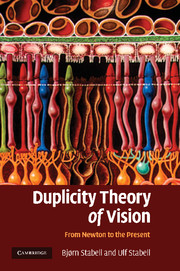Book contents
- Frontmatter
- Contents
- Acknowledgements
- 1 Introduction
- Part I The development of the basic ideas of the duplicity theory from Newton to G. E. Müller
- Part II The development of the duplicity theory from 1930–1966
- Part III Chromatic rod vision: a historical account
- Part IV Theories of sensitivity regulation of the rod and cone systems: a historical account
- Part V Factors that triggered the paradigm shifts in the development of the duplicity theory
- References
- Index
- References
References
Published online by Cambridge University Press: 22 January 2010
- Frontmatter
- Contents
- Acknowledgements
- 1 Introduction
- Part I The development of the basic ideas of the duplicity theory from Newton to G. E. Müller
- Part II The development of the duplicity theory from 1930–1966
- Part III Chromatic rod vision: a historical account
- Part IV Theories of sensitivity regulation of the rod and cone systems: a historical account
- Part V Factors that triggered the paradigm shifts in the development of the duplicity theory
- References
- Index
- References
- Type
- Chapter
- Information
- Duplicity Theory of VisionFrom Newton to the Present, pp. 207 - 220Publisher: Cambridge University PressPrint publication year: 2009



